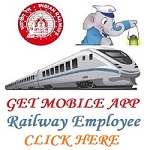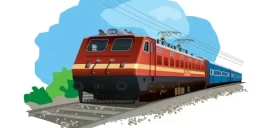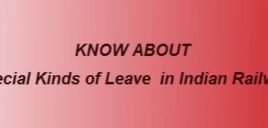BRAKE SYSTEM
Braking: dissipation of amount of kinetic energy into heat energy so as to retard wheel motion is called breaking.
IRAB-1 brake system – Locomotive fitted with IRAB-1 brake system can work only on air brake stock.
Various valves and cocks are provided in IRAB1 brake system
A9 Valve – It is pressure reducing, pressure maintaining and self lapping valve. It is provided on both control stands; it reduced main reservoir pressure 8-10 kg/cm² to 5 kg/cm² and has 4 ports 30, 5, 1 and exhaust. Its handle has 5 positions –
1. Release
2. Minimum reduction
3. Full service
4. Over reduction
5. Emergency

SA9 Valve – It is pressure reducing, pressure maintaining and self lapping valve. It is provided on both control stands; used for applying locomotive brakes and has two positions
1- Release
2- Application
It has five ports 30, 20 and exhaust.
MU2B Valve – It is provided on air brake panel in Nose Compartment have 2 positions lead and trail/Dead. It is provided for Loco brake operation, BP charging, F-1 selector valve. It has eight ports 2, 20, 3, 13, 63, 53, 30 and Exhaust. It should be kept in lead position in leading loco and in trail position on trailing loco in MU operation.
The following ports are connected when it is in lead position port No. 2- 20, 3-13, 63-53 and 30 with Exhaust port and in trail position port No. 63- 30 and 53 with Exhaust.
24AD Check Valve – This valve is also called double acting check valve. It is used where possibility of two different pressure coming to operate single valve.
C2 Relay Valve – This valve is provided on air brake panel in Nose Compartment. It is used to charge brake cylinders and brake cylinder equalizing pipe. It has four ports 1, 2, 3 and Exhaust port.
Add C2 Relay Valve – This valve is provided on air brake panel in Nose Compartment. When A9 in release position it charges the brake pipe. It has four ports 1, 2, 3 and Exhaust.
¾” COC – It is provided on air brake panel in Nose Compartment. It also called brake pipe isolating cock. In single loco and leading loco of multiple units it should be in open position and closed in trailing loco.
F1 Selector Valve – This valve is provided on air brake panel in Nose Compartment. It is controlled by MU2B valve. It helps in charging brake cylinder equalizing pipe and loco brake application in conjunction working.
When loco parts while working multiple unit light engine MR EQ. pressure dropped which makes F-1 selector valve partially in lead position on trailing loco and loco brake applied in conjunction working. This valve has nine ports 30,14,4,16,20,12,15,63,53.
Power cut off pressure switch – It is provided in nose compartment with COC. When ever BP pressure less then 2.8kg/cm2 due to any reason this pressure switch operates and de-energize DMR. This valve is provided in nose compartment on brake panel.
D24B Feed Valve – This valve is provided on air brake panel in Nose Compartment. It is a pressure reducing self lapping valve. It reduced MR1 pressure in to 6 kg/cm2 to charge feed pipe.
1 ¼ COC – It is provided on air brake panel in Nose Compartment. It is used to isolate D24B feed valve.
Duplex check valve – This valve is located near MR1. It works as a non return valve. When MR pressure is built up more than 5kg/cm2, it operates and allows the pressure to charge MR equalizing pipe and feed pipe pressure.
D-1 Emergency Flap Valve – It is provided behind both driving seats. This valve is directly connected to brake pipe. When this valve is lifted brake pipe pressure drops. It is used in emergency conditions.
N1 Limit Valve – It is provided on air brake panel in Nose Compartment. It reduced MR pressure up to 1.8 kg /cm2.
C3W distributor valve – It is located in nose compartment. It controls conjunction working in IRAB-1 System. This valve having 4 ports viz. BP, MR, EX, SP. The BP chamber is connected to control chamber through non return chock, chock allowed air from BP chamber to control chamber. It has one isolating handle having two positions service and isolation. It has also ‘P’ & ‘G’ handle, while working passenger train this handle should be on ‘P’ position and with goods train it should be on ‘G’ position. According to the position of handle loco brake application and releasing time is fixed.
This valve has one manual release handle which is used to release loco brake manually in conjunction braking.
Foot paddle switch- It is provided in front of both loco pilot driving seat ,used to release loco brake during conjunction braking by pressing foot paddle switch.
Application and releasing of Loco brake – SA9 valve is fitted for independent application and release of loco brakes in IRAB1 brake system. SA9 valve has 2 positions.
Application – In this position loco brakes are applied.
Release – In this position loco brakes are released.
Loco brake application – When SA-9 valve handle is kept in application position its port no. 30 and 20 connected, adjusted pressure of 3.0 kg/cm2 by feed cock discharge from port no. 20 and goes to MU2B valve port no. 2 through 24AD check valve. Since MU2B valve is in lead position, its port no. 2 is connected to 20, the pressure comes out from port no.20 and goes to C2 Relay valve port no.2 through 24AD check valve and C2 relay valve operated. C2 Relay valve port no.1 and 3 connected, waiting pressure of MR2 on port no. 1 will discharge from port no. 3 in proportionate to the pressure of port no. 2 which is 3.0 kg/cm2 and goes to following places
1. Through boogie cut out cock to brake cylinder and operates loco brakes.
2. To charge brake cylinder equalizing pipe through F1 selector valve port no. 30 and 14
Loco brake releasing – When SA-9 handle is kept in release position, its port no. 20 disconnected from 30 and gets connected to exhaust port. Air pressure in C2 relay valve port no. 2 will exhaust through MU2B and SA9 valve exhaust port. As there is no pressure in C2 relay valve port no.2, its port no. 3 is disconnected from 1 and gets connected to its exhaust port, brakes cylinder pressure exhaust from C2 relay valve exhaust port and loco brake will released.
Note –
1. In some locos SA9 COC is provided in control stand, Working control stand COC should be kept open and non working control stand in close position.
2. Brake cylinder pressure gauge is provided on both the control stand to show brake cylinder pressure.
3. Boogie isolating cock is provided on loco right side in under frame for both boogies to isolate loco brake.
4. Brake cylinder pressure gauge will not show if front boogie is isolated.
Procedure of brake cylinder pressure adjustment –
1. Ensure MR pressure should be 8 to 10 kg/cm2
2. Ensure MU2B on lead position
3. Both bogies isolating cock should be in open condition.
4. Both end brake cylinder equalizing pipe COC should be in close condition.
5. Keep SA9 handle of working control stand in application and adjust 3.0 kg/cm2 with the help of its feed cock.
Loco brakes not applying
Brake pipe charging
Waiting MR2 pressure on port no. 30 of A9 valve goes to port no. 5 when A9 handle kept on release position. Adjusted pressure of 5 kg/cm2 by A9 feed cock will discharge from port no. 5 to MU2B valve port no. 3 through A9 COC (when it is in open condition). Since MU2B valve in lead position hence its port no. 3 &13 are connected and pressure on port no. 3 will discharge from port no. 13 and will go to Add.C2 relay valve port no.2, also charged the 110 cubic inch reservoir. Add C2 relay valve gets operated when air comes on its port no.2 hence ts port no.1 & 3 are connected and waiting pressure of MR2 will reduced proportionately and discharged from port no. 3 and charged BP pressure 5.0 kg/cm2 when ¾” coc in open condition.
BP Discharging (dropping) When A9 valve handle kept on application position, its port no.5 is disconnected from port no.30 and connected to exhaust port hence Add C2 relay valve port no.2 air will return via same passage to exhaust port, as per A9 handle position. Add C2 relay valve disturb from its lap position and port no.3 will connect to exhaust port, BP pressure will exhaust and its pressure dropped.
Procedure of BP pressure adjusting-
1. Ensure MR pressure should be 8 to 10 kg/cm2
2. Working control stand A9 COC should be in open condition and None working in closed
3. Ensure MU2B on lead position
4. Ensure ¾ inch coc in open condition
5. Ensure both end of BP angle cock of loco is in closed condition
6. Ensure both emergency flap valve in closed condition
7. Keep A9 handle of working control stand in release position and adjust 5.0 kg/cm2 by feed cock.
BP pressure not builds up-
BP pressure not dropping by A9 -In this condition stop the train by using emergency flap valve and trouble shoot the following
Conjunction braking- When BP pressure is 5.0kg/cm2 that time BP chamber and control chamber of C3W valve also charged with 5.0kg/cm2 , in this position distributor valve is in balance position and loco brake are in released position.
Application position – when train brakes applied through A9, BP chamber of C3W drop and distributor valve is operated hence MR port is connected to SP port. Air from SP port goes to N1 limit valve which is set on maximum 1.8kg/cm2 pressure. From here air goes to C2 relay valve port no.2 through D1 pilot valve, F1 selector valve port no. 4 -16 and loco brake applied.
Release position – When A9 handle kept on releases position to release train brake that time C3W distributor valve BP chamber and control chamber charged with 5.0kg/cm2 pressure and valve comes in balanced position. Hence air of C2 relay valve port no.2 will exhaust from C3W distributor valve exhaust port through same passage and loco brake also released.
Note-
During dynamic brake application or on pressing foot paddle switch D1 pilot valve gets energize and air from C2 relay valve port no.2 will exhaust from D1 pilot valve exhaust port hence applied loco brake in conjunction braking get released.
Feed Pipe Charging
Twin pipe brake system is developed to increase the efficiency of air brake system it include FP along with the BP. Feed pipe is charged with 6.0kg/cm2 pressure, all auxiliary reservoir of wagon/coaches are charged by feed pipe in twin pipe brake system. In loco feed pipe is charged by 6.0kg/cm2 from MR1 through duplex check valve, 11 /4 inch, D24B feed valve and both end FP angle cock should be in close position.

IRAVB1 (DUAL BRAKE)
IRAVB1 brake system is provided in some WDG3A locos. IRAVB1 brake system fitted loco can work with both air and vacuum brake trains.
VA1B Control Valve – It is provided in nose compartment. It helps in vacuum creation and destruction. It connects train pipe with exhauster or atmosphere as required. It has one dumble, when it is in balance position train pipe is connected to the exhauster and in unbalanced position connected to atmosphere. It has nine ports 3, 6, 7, 8, 2, 1, 11, 13 and exhaust.
HS4 Valve – It is provided in nose compartment. MR2 pressure is reduced by its feed cock to 24±1 psi which goes at the bottom of VA1B valve to balance dumble. This pressure is called vacuum control air pressure.
GD8OD & GD80E Filter – These filters are located in Nose compartment to clean atmosphere and train pipe air.
Check Valve – It is located in Nose compartment. It allows atmospheric air into the train pipe but not vice versa. It is also called non return valve.
Banking cock (ghat cock) – It is located in nose compartment. In normal working it should be in open position and closed in banking/ dead loco.
D1 Pilot Valve – It is provided in nose compartment. It is electropneumatic valve, during dynamic braking it gets energies and keeps the loco brake in release position in conjunction working. It has four ports IN, OUT, MR and Exhaust.
HB5 Valve – It is located in nose compartment. While working vacuum brake train when vacuum drops up to 35cm without dropping BP pressure, it operates PCS. This valve has six ports 9, 10, 11, 12, 13 and Exhaust.
PCS 1– It is located in nose compartment, it is operated by HB-5 valve. When it operates DMR de-energize.
A1 Differential Pilot Valve – It is located in nose compartment. Its working is
1. While working multiple unit, trailing loco helps in vacuum creation for short time after releasing A-9.
2. It avoids operating HB-5 valve after releasing A-9.
D-1 Emergency Flap Valve – It is provided behind both driving seats. This valve is directly connected to train pipe and brake pipe. When this valve is lifted up to 45º train pipe vacuum drops and on 90 º brake pipe pressure drops. It is used in emergency conditions.
Vacuum adjustment –
1. Ensure BP pressure is 5.0 kg/cm2
2. Banking coc should be open.
3. Emergency flap valve should be close.
4. Both hosepipes should be on dummy.
5. Adjust HS4 pressure 24 +_1 psi by its feed cock.

Vacuum creation in train pipeWhen A9 handle is kept in release position, BP pressure (5.0 kg/cm2 ) will go to VA1B valve port no.3 i.e. on the top diaphragm and from HS4 valve 24±1 psi pressure goes to port no.1 i.e. under the bottom diaphragm hence VA1B valve comes in balance position. In this condition port no.6 of VA1B valve is connected to 7. VA1B valve port no.6 is connected to train pipe and port no.7 to exhauster through vacuum reservoir.
Exhauster sucks air of train pipe through banking cock, VA1 release valve, GD80E filter, VA1B control valve, vacuum reservoir and throw it to atmosphere through exhaust pipe due to this vacuum create in train pipe, amount of vacuum can be seen in gauge on both control stands. Note – Two pressures operates VA1 release valve, one is from port no.53 of MU2B valve when it is in lead position and/ from A1 differential valve.
Destruction of vacuum of train pipe- When A9 handle kept in application position, BP pressure drops. Due to reduction in BP pressure, pressure reduced on VA1B control valve top diaphragm hence valve gets unbalance and its port no.6 gets connected to 8. Atmosphere air enters from GD80D filter, VA1B control valve, vacuum check valve, banking coc and destroy the vacuum in train pipe.
Recreation of vacuum in train pipe- After application of brake when A9 kept on release position to release the train brakes, BP pressure will charge again 5.0 kg/cm2 and VA1B control valve comes in balance condition. Recreation of vacuum will start in train pipe
HB5 Valve – While working vacuum brake, A9 in release position and train parts / vacuum hose pipe uncouples / emergency flap valve open / brake applied by guard then atmospheric air enters in train pipe , air comes in VA1B control valve port no.2 and press the bottom diaphragm downward. In this condition VA1B control valve port no.1 is connected to port no.11 and 24 psi pressure goes to HB5 port no.10 through port HB5 valve operates due to which its port no.12 is connected to 11. On MR Pressure waiting of port no.12 goes to PCS through 24AD check valve and operates PCS hence DMR de-energize and changes takes on loco
1. Electric brake warning lamp (PCS) will glow on both control stands.
2. Engine speed comes to idle.
3. If dynamic brakes were in applied condition it will cut off.
4. If throttle handle on notches first notch current will go to TM.
After necessary trouble shooting when vacuum recreate in train pipe HB5 valve reset and air exhaust from VA1B control chock. Since HB5 valve reset its port no.11 disconnected from port no.12 and connected to exhaust port hence PCS will reset. One isolating cock is provided to isolate this valve.
A1 differential valve:- This valve is fitted in nose compartment; one reservoir is connected to it through COC. When COC is in open condition its port no.1 is connected to BP and port no.2 is connected to –
1. VA1 Release valve through 24AD check valve
2. Port no.13 of HB5
3. Port no.12 of VA1B control valve
When A9 is in release position, then port no.1 of A1 differential pilot valve and its reservoir is charged by BP pressure.
Whenever A9 handle kept on release position after application that time its port no.1 &2 is connected till reservoir is recharged up to 5.0kg/cm2, in between following action will take place –
1. In multiple unit loco, MU2B of trailing loco is in trail/dead position hence VA1 release valve does not operate due to any air, where as VA1B valve in balance position but not creating vacuum. When A9 handle kept on release position after application, A1 Differential pilot valve operates and send air to VA1 release valve hence trailing loco helps in creating vacuum for some time.
2. When vacuum drops in train pipe through A9 and further A9 kept on release position that time circumstances arise to operates HB5 but in this situation HB5 does not operates since on its port no.13 air comes from A1 differential pilot valve.
Above all action will take place till the A1 differential pilot valve reservoir is charged by 5kg/cm2
When reservoir is charged port no.1 &2 are disconnected and pressure of port no.2 is exhaust through VA1B control valve chock.
Vacuum is not creating in train pipe

Various test of brake system
Vacuum test
Purpose – To check the vacuum creation capacity of the Exhauster
Apparatus – Test plate of 8mm dia leak hole.
Procedure –
1. Ensure the BP pressure; it should be 5kg/cm2.
2. Ensure vacuum control pressure; it should be 24±1psi.
3. Keep both side hose pipe on dummy and ensure that vacuum in train pipe is 58 cm.
4. Keep A9 handle in emergency position.
5. Remove the hose pipe in rear and put 8mm dia hole test plate on it.
6. Keep A9 handle in release position
7. After keeping A9 handle in release position 53 cm vacuum should be created in 45 sec
8. If 53cm vacuum is not created with in 45 seconds, then the loco to be considered fail for vacuum brake train.
Orifice test
Purpose – To check the capacity of compressor.
Instrument – Dummy palm with 7.5mm leak hole. Procedure –
1. MR pressure should be 8-10 kg/cm2
2. BP Pressure should be 5kg/cm2
3. Open BP angle cock slightly of one end to drain moisture and close it.
4. Fit the Orifice test Instrument on BP palm and open its angle cock.
5. In Auto flasher unit fitted loco after opening angle cock,
a. With pressing SP-1/SP-2, BP pressure drops up to 0.6 kg/cm2 in 1minutes.
b. With out pressing SP-1/SP-2, BP pressure drops 1.5 to 2.5 kg/cm2 in 1minutes.
Note :- With out auto flasher unit fitted loco, after opening angle cock BP pressure should not drop more than 1 kg/cm2 in one minute.
Leak off test
Purpose : To check the leakage of Brake pipe in the loco
Procedure:
1. MR pressure should be 8-10 kg/cm2
2. BP pressure should be 5kg/cm2
3. Drop BP pressure up to 1 kg/cm2 by A9 handle and let it be stable.
4. Close the ¾ “COC, BP pressure should not be drop more than0.7 kg/cm2 in 5 minutes after closing the COC.
6. If the BP pressure drops more than 0.7kg/cm2 then this loco is considered fail for air brake train.
Hand brake
It is provided in loco Pilot cab. It is used to apply on stable loco, dead loco, on down gradient etc to avoid roll down. It has two handles –
Operating handle – It is used to apply hand brake, handle to be operate to up-down direction till the chain is tide on R1 brake cylinder piston, piston will came out and three brake blocks of R 1 & R 2 operated.
Release Handle – It is in small size, to release hand brake it required to pull the handle in one stroke.
Note-
1. Before starting the train or loco ensures hand brakes are in release condition.
2. In some loco modified hand brake provided with wheel handle for operation of hand brake.











